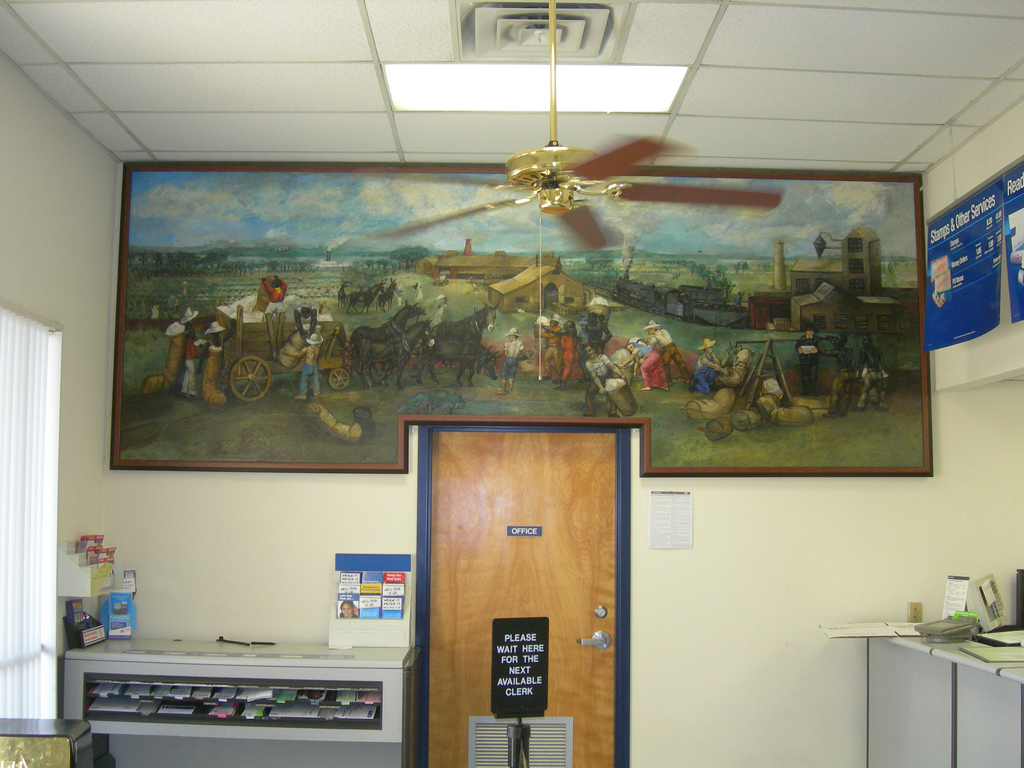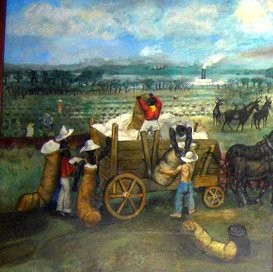- City:
- Jackson, GA
- Site Type:
- Art Works, Murals
- New Deal Agencies:
- Arts Programs, Treasury Section of Fine Arts (TSFA)
- Completed:
- 1940
- Artist:
- Philip Evergood
Description
This Section of Fine Arts mural, entitled “Cotton–From Field to Mill,” was painted in 1940 by Philip Evergood, for the then-new Jackson post office at 132 S Mulberry St. It was moved to the retail lobby of the current post office building upon its relocation in 1995.
Following alleged complaints regarding the content of the mural, it was covered with black plastic in August 2020 while its fate is determined (Jackson Progress-Argus).
Source notes
https://www.newdealartregistry.org/
https://forumgallery.com/artist/philip-evergood/about/
https://www.wpamurals.org/Georgia.htm
https://www.flickr.com/photos/auvet/2194109458/
https://www.jacksonprogress-argus.com/news/after-alleged-complaints-82-year-old-mural-in-jackson-post-office-may-be-removed/article_14aa9e3e-de67-11ea-ad87-1b377bbcbfa9.html
At this Location:
Contribute to this Site
We welcome contributions of additional information on any New Deal site.
Submit More Information or Photographs for this New Deal Site

This mural is VERY concerning in these times. Please take it down and put it in a museum if need be. We NEED something more progressive to replace it with. Something that brings our community together. We do not need to glorify slavery or anything that looks like it. I will be forwarding this to the appropriate channels.
I note that the writer has singled out a small portion of the mural, saying “we do not need to glorify slavery or anything that looks like it.” It is interesting that the writer shows their bias by ignoring other parts of the painting which show white farm workers engaged alongside black workers in the agricultural activity of bringing cotton from the field to be taken to the mill. The painting is about hard times for everyone in the South during the depression.
It is also interesting that the “I don’t like it so take it down” mentality, in this case, shows that the writer has not taken the time to find out more about the painting. The artist, Philip Evergood (1901-1973) is a noted American painter who completed the mural in 1938 under a commission from the depression era WPA. It is one of hundreds of such murals all across the country. And contrary to the writer’s mistaken view, it does not “glorify” slavery. In fact, he was personally involved in liberal and radical causes during his life and was devoted to egalitarian ideals. Information on the internet from the Smithsonian Museum tells us that his early paintings [like the Jackson Post Office mural] “are statements of sympathy for those who struggle against oppression.”
So, how about if the writer supports something positive and progressive in addition to this important depression era treasure? Unfortunately, the negative “remove it” movement seems to have won in this case, as I just learned that the local post office has decided to remove the mural because some people find it “offensive.” So disappointing.
This mural is a representation of southern life when cotton was king. My husband picked cotton as a child. He is white, and picked alongside white and black people. It was part of their life and I wish this mural and all the others this artist painted could remain where they are. A proud view of old time southern economy.
It is such a shame that people do not spend more time researching the history of a painting before complaining. This painting as so many others completed and hung in US Post Offices during this time period were specifically done as a means of providing (or trying to anyway) the local community some relief and enjoyment from the years of the Great Depression. The paintings were supposed to refect the “character” of the community where they would be hung and since 1940 Jackson was a farming community, primarily existing off of the growing of cotton and the production of it in the local mill; the painting seems very appropriate to me. Also, the artist Philip Evergood, was the Jewish son of immigrants, born in New York, raised in England. He struggled much of his life to find commercial success and he was well known for his ideological views, some in which he painted portraits of scenes portraying starving children in America, lynchings, and prisoners being mistreated. He was later blacklisted in 1950’s for his Socialist leanings. His works are on display all over the world, including the Vatican, the Smithsonian, the Museum of Modern Art in New York City and many others. It is disappointing that because of the climate today we cannot appreciate the history of the past.
As I walked into the lobby of the Jackson Georgia Post Office, I noticed the mural that normally greets me was covered with dark plastic. It is a mural of farm life in the south, during the depression. I found myself at the point of tears. The thought of how our history can be erased is extremely troublesome. The artist had white and black working side by side, during a time of survival. How anyone can declare this painting offensive and demand its removal, has no understanding of history.